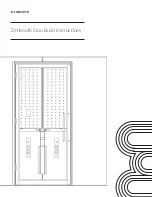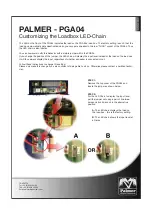
General >> Working with Arma-Chek D
© ARMACELL UK LTD.
D
APPLICATION MANUAL
1 - General >> Working with Arma-Chek D
CORRECT USE OF ARMAFLEX ADHESIVE
There are three types of accessories currently
available:
• Armafl ex adhesive (520 & HT625)
• Arma-Chek Black Mastic
• Arma-Chek D self-adhesive tapes
ARMAFLEX ADHESIVE
Adhesives to use are:
Armafl ex adhesive HT 625 (bonding of HT/Armafl ex)
Armafl ex adhesive 520 (all other Armafl ex elastomerics)
a) Before use shake and stir the adhesive thoroughly.
Keep container/adhesive holder closed when not in
use.
b) Use brushes with short, stiff bristles. Alternatively the
Armafl ex adhesive gluemaster can be used when
working with the adhesive.
c) Application procedures for installing the Arma-Chek
covering to fl at and large surface area’s, where all-
over adhesive coverage is required:
For Arma-Chek D covering adhesive is
only
required
on the Armafl ex surface and on the overlapping area.
Always ensure there is all over adhesive coverage
with no signs of “dry spots” where applicable, such
as fl at surfaces, vessels and piping diameters above
500mm. The Arma-Chek D covering is to be fi xed and
secured immediately, no “tack “time is required.
Note: If the Armafl ex surfaces are left to two tack”
dry, they will not bond when pressure is applied.
When this happens you can re-activate by applying a
further fi lm of Armafl ex adhesive.
A short pile fabric paint roller/ large paint brush may
be preferred on large circular and fl at surface areas.
d) Allow the adhesive to “tack-dry” on overlapping
details . The “tack”-time depends on the thickness of
the adhesive layer and the ambient conditions
(temperature, relative humidity, air movement). The
correct initial drying time is checked by the “fi nger-
nail test”: Touch the surface with a fi ngernail, if the
fi ngernail does not adhere to the surface and the
surface itself does not feel tacky the covering can be
positioned and fi xed using hand pressure, a dry paint
roller or a big brush to bond the covering to the
Armafl ex.
Apply pressure to the entire surface, smoothing the
covering round making sure there are no air pockets
present. Always check for alignment and avoid
“creases and crinkles” during that time.
e) If the surfaces are left to dry too long, they will not
bond when pressure is applied. When this happens
you can re-activate by applying a further fi lm of
Armafl ex adhesive following steps b) to d).
f) In general, the application of adhesives should not be
carried out when the ambient temperature is below
0 °C or the relative humidity is higher than 80% (for
further information see application hints for Armafl ex
adhesives).
g) Use Armafl ex cleaner to clean your tools, con-
taminated Arma-Chek and all seam and joint details
within the Arma-Chek R system, prior to applying the
bead of Arma-Chek mastic.
ARMA-CHEK MASTIC
The Arma-Chek mastic is an adhesive and a sealing
product designed to give additional and long life protec-
tion to all Arma-Chek glued seams and joints in external
environments and area’s internally that require “wash-
down”.
1. Before applying the mastic to all seams and joints,
check that they are completely sealed with the
correct type of Armafl ex adhesive, and securely fi xed
down (see item 6 below).
2. Check that the seams and joints are clean, dry
and free from contamination before applying the
mastic. All seam and jointing details contained within
the Arma-Chek R coverings, shall be cleaned with
Armafl ex Cleaner/local solvent cleaner, before
applying the Arma-Chek mastic.
3. All seams and joints to have an allowance of a
minimum of 10 mm wide and 3 mm thick mastic
“beading” applied.
4. Smooth the mastic, with the use of a mastic spoon
or a fi nger (use washing up liquid and water). The
fi nish of the mastic can be enhanced by „masking“ off
5 mm either side of the seams and joints, prior to the
application of the mastic. Proceed to remove the
“masking tape” while the mastic is in its wet state
(Take care on health and safety issues!!)
5. In general, the application of the mastic should not be
carried out when the ambient temperature is below
+5 °C or the relative humidity is higher than 80%.
6. The Arma-Chek mastic should not be used on a stand
alone basis to fi x and bond the coverings (see item 1
above).
(2) D





































